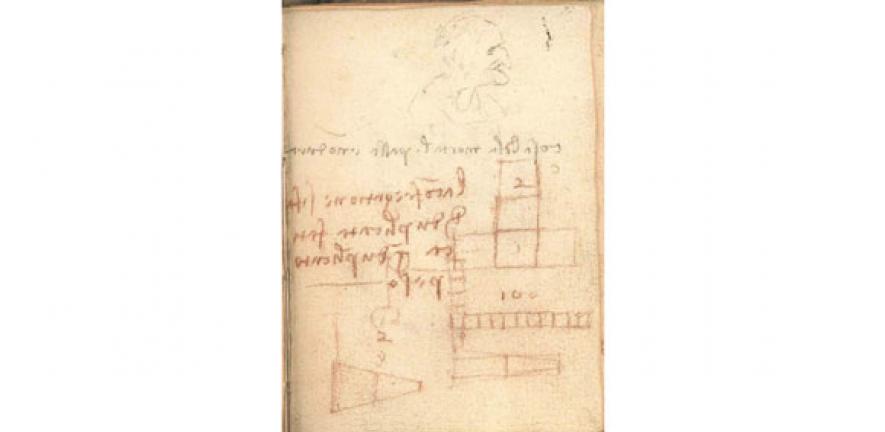
A new detailed study of notes and sketches by Leonardo da Vinci has identified a page of scribbles in a tiny notebook as the place where Leonardo first recorded the laws of friction. The research also shows that he went on to apply this knowledge repeatedly to mechanical problems for more than 20 years.
A new detailed study of notes and sketches by Leonardo da Vinci has identified a page of scribbles in a tiny notebook as the place where Leonardo first recorded the laws of friction. The research also shows that he went on to apply this knowledge repeatedly to mechanical problems for more than 20 years.
The sketches and text show Leonardo understood the fundamentals of friction in 1493
Ian Hutchings
Scribbled notes and sketches on a page in a notebook by Leonardo da Vinci, previously dismissed as irrelevant by an art historian, have been identified as the place where he first recorded his understanding of the laws of friction.
The research by Professor Ian Hutchings, Professor of Manufacturing Engineering at the University of Cambridge and a Fellow of St John’s College, is the first detailed chronological study of Leonardo’s work on friction, and has also shown how he continued to apply his knowledge of the subject to wider work on machines over the next two decades.
It is widely known that Leonardo conducted the first systematic study of friction, which underpins the modern science of “tribology”, but exactly when and how he developed these ideas has been uncertain until now.
Professor Hutchings has discovered that Leonardo’s first statement of the laws of friction is in a tiny notebook measuring just 92 mm x 63 mm. The book, which dates from 1493 and is now held in the Victoria and Albert Museum in London, contains a statement scribbled quickly in Leonardo’s characteristic “mirror writing” from right to left.
Ironically the page had already attracted interest because it also carries a sketch of an old woman in black pencil with a line below reading “cosa bella mortal passa e non dura”, which can be translated as “mortal beauty passes and does not last”. Amid debate surrounding the significance of the quote and speculation that the sketch could represent an aged Helen of Troy, the Director of the V & A in the 1920s referred to the jottings below as “irrelevant notes and diagrams in red chalk”.
Professor Hutchings’s study has, however, revealed that the script and diagrams in red are of great interest to the history of tribology, marking a pivotal moment in Leonardo’s work on the subject.
The rough geometrical figures underneath Leonardo’s red notes show rows of blocks being pulled by a weight hanging over a pulley – in exactly the same kind of experiment students might do today to demonstrate the laws of friction.
Professor Hutchings said: “The sketches and text show Leonardo understood the fundamentals of friction in 1493. He knew that the force of friction acting between two sliding surfaces is proportional to the load pressing the surfaces together and that friction is independent of the apparent area of contact between the two surfaces. These are the ‘laws of friction’ that we nowadays usually credit to a French scientist, Guillaume Amontons, working two hundred years later.”
“Leonardo’s 20-year study of friction, which incorporated his empirical understanding into models for several mechanical systems, confirms his position as a remarkable and inspirational pioneer of tribology.”
Professor Hutchings’s research traces a clear path of development in Leonardo’s studies of friction and demonstrates that he realised that friction, while sometimes useful and even essential, also played a key role in limiting the efficiency of machines.
Sketches of machine elements and mechanisms are pervasive in Leonardo’s notebooks and he used his remarkably sophisticated understanding of friction to analyse the behaviour of wheels and axles, screw threads and pulleys, all important components of the complicated machines he sketched.
He wanted to understand the rules that governed the operation of these machines and knew that friction was important in limiting their efficiency and precision, grasping, for example, that resistance to the rotation of a wheel arose from friction at the axle bearing and calculating its effect.
“Leonardo’s sketches and notes were undoubtedly based on experiments, probably with lubricated contacts,” added Hutchings. “He appreciated that friction depends on the nature of surfaces and the state of lubrication and his use and understanding of the ratios between frictional force and weight was much more nuanced than many have suggested.”
Although he undoubtedly discovered the laws of friction, Leonardo’s work had no influence on the development of the subject over the following centuries and it was certainly unknown to Amontons.
“Leonardo da Vinci’s studies of friction” by Professor Ian Hutchings is published in the journal Wear. The paper can be accessed in full via: https://www.sciencedirect.com/science/article/pii/S0043164816300588
or https://www.ifm.eng.cam.ac.uk/uploads/Hutchings_Leonardo_Friction_2016_v2.pdf
A general article on tribology that discusses its importance in modern engineering can be found at:
https://www.ingenia.org.uk/Content/ingenia/issues/issue66/hutchings.pdf

The text in this work is licensed under a Creative Commons Attribution 4.0 International License. For image use please see separate credits above.




